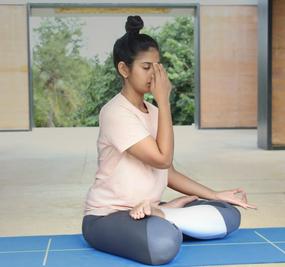What is The Problem?
A “normal” period. What!! That’s an oxymoron, right?!? Some women go through their menstrual cycle with fewer or no concerns. However, for the rest, the time of the month comes with cramps, mood swings, food cravings, fatigue, or just plain annoyance. There is a sharp rise in the ratio of women experiencing physical, psychological, and emotional discomforts around the menstrual cycle. Irregular periods, heavy bleeding and unmanageable mood swings are some of the most common menstrual disorders. Polycystic Ovarian Disease (PCOD), also known as Polycystic Ovary syndrome (PCOS) are more specific conditions affecting women around the world. Looking at the larger picture, the repercussions of menstrual issues are not just restricted to the woman going through the cycle. Spouses, kids, parents, roommates, colleagues are also affected as the inconvenience and discomforts spill over relationships, work, and academics. So regardless of your gender, let’s find out who is responsible for this ovary-action?
The Hormones!!
The hormonal system also referred to as the endocrine system is a network of glands and organs in the body that produces hormones. Hormones are used to communicate between organs and tissues for physiological regulation and drive behaviour. Hormones are directly and indirectly involved in functions like metabolism, respiration, circulation, sleep, growth and development, reproduction, mood and more. This should explain all the drama caused by imbalance in hormones. The menstrual cycle is also regulated by hormones. Hormones are the unsung heroes of this intricate and progenitive mechanism. However, these heroes turn rebellious if not kept under a check. 5% to 10% of women in the age group 12-45 years are affected with PCOD/PCOS, conditions caused by imbalance in hormones.
What Triggers all the Drama?
Human anatomy is a beautiful and complex interaction of different systems working together towards overall well-being. However, any kind of disruptions in this system can throw the body off balance. Hormonal imbalance is one such disruption. Hormonal imbalances are caused by lifestyle factors like unmanaged stress, poor diet, and lack of exercise. The whirlwind schedules of today’s life induce tremendous stress leaving the mind and body exhausted. Adrenal gland is responsible for the stress response in the body and constant exposure to stress leads to depleted adrenal glands. Fast food, popularly called junk food (for a reason) qualifies for higher consumption of carbohydrates and sugar. Pancreas support the system by producing enough insulin to offset all the sugar intake leading to overworked pancreas. To top it all, our sedentary jobs eliminate the possibility of physical movement in our routines. When we don’t get enough exercise, our lymphatic system suffers as it cannot move the toxins out of our bodies. These are few examples of how our lifestyle and unhealthy choices contribute to overworked glands. This in turn hinders the optimal functioning of the vital mechanisms in the body including the menstrual cycle.
How Yoga Helps
Bringing the body back to balance needs a holistic approach that includes physical movement and stress management. What better than yoga to retrieve harmony between the body and mind. The role of yoga in health and well-being with the primary effect of eliminating stress has been well documented through elaborate studies and research. The physical postures (asanas) relieve congestion in the body and promote circulation through flexing and stretching. Thereby, creating a cleansing and rejuvenating effect on the body aiding cramp free periods. And breath work (pranayama) activates the parasympathetic system inducing calm, alleviating mood swings, depression, anxiety, irritability etc. Yoga is a handy tool for inviting more oxygen, which acts as a source of energy and nutrition for an overworked body and distressed mind. A daily yoga practice is a perfect doze to maintain hormonal balance thereby regulating and easing the menstrual cycle.
Recommended Yoga Poses and Pranayama
Baddha Konasana
Also known as Butterfly or Cobbler’s pose opens the pelvic region working on hip muscles.
Supta Baddha Konasana
This is a reclined version of Cobbler’s Pose, Supta Baddha Konasana or the Goddess Pose. The pose helps open the groin and hips while relaxing.
Matsyasana
Energizes the body and stimulates the abdominal muscles relieving menstrual pain. It helps fight fatigue and anxiety.
Janu Sirsasana
Janu Sirsasana – Head to Knee pose is a simple seated forward bend. Allows you to gently extend and lengthen your hips and groin. Massages the abdominal organs, thus relieving pain caused by menstrual cramps.
Bridge Pose
This is a gentle backbend that can help relieve back pain associated with menstruation. Relieves symptoms of menopause and menstrual pain.
Savasana
Savasana (Corpse Pose) is another useful pose. Lie down flat on your mat with the spine resting on the ground. Palms facing the sky and feet naturally falling out. This will help you unwind completely at the end of your yoga session.
Furthermore, some gentle pranayama practices like Anulom Vilom (alternate nostril breath), Ujjayi (victorious breath) or simple deep breathing can be very useful too. Yoga Nindra and meditation can be your best friends during the period. The more you relax, the better you feel. A consistent and healthy yoga ritual can be as soothing as your heat pad and curb the need for popping pain killers.
A plethora of opportunities and fun are awaiting you and you can have it all. Women empowerment is not a topic of academic and cultural debate anymore. It is right here, don’t let your cycle stop you from attending that important meeting or a close friend’s birthday party. You deserve to be comfortable and at ease with your body for all days of the month – those days inclusive. Menstrual cycle is a monthly reminder to celebrate womanhood. Let this reminder be as gentle as mother nature can be.
Fertility is a boon and reproduction is the fruit on which mankind thrives. Menstruation is a sign of the power a woman holds inside her body; that she can create and sustain life. And this is why women are symbolized as Goddess (Devi) according to Hindu scriptures and mythology. Yoga is the tool to transform and live this blessing rather than dread through it. Augment your reproductive health, ensure consistent and pain free periods and uplift your well being, with yoga.








